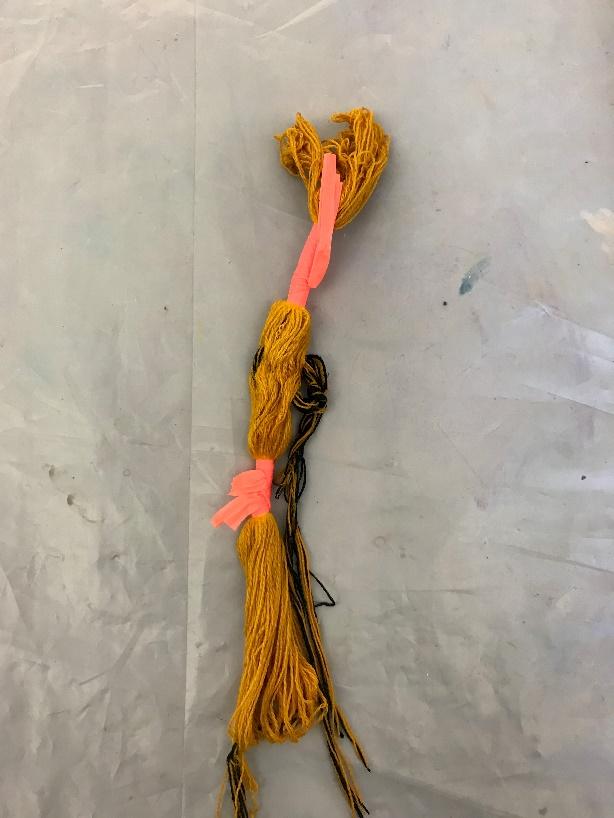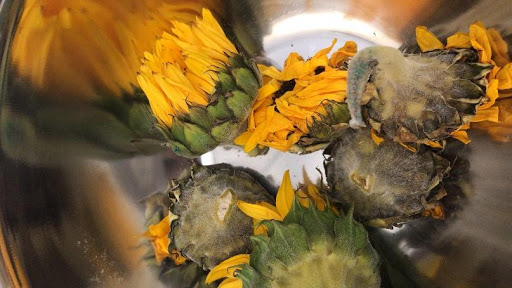Hello everyone, my name is Mari! I am a 24-year-old senior in the Fibers program at UNT. Yarn has been in my life for as long as I can remember and as a fiber artist, it is the most important tool in my life! When I learned about different dye processes, for some reason I was immediately drawn to the natural dye process. I was drawn to this process because it is something that I can continue to grow with as a practicing artist and you continue to learn something different. I am so excited to share this process with you so you can create your own colors! Below is a woven shibori dyed in indigo.

Choosing your Yarn
First, you need to pick the yarn; you can use cotton, bamboo, wool, silk, linen or another natural material (i.e. cellulose or protein fiber). If you use cellulose fiber (a.k.a cotton, bamboo, linen, etc.) you will need to mordant your yarn; if you are using wool or a protein yarn, you don’t need to mordant it.
The Mordant Process
Mordant? What does mordant mean? Mordant means you treat the material so the dye sticks to the fiber. It is the preparation of your yarn for the dye to adhere to the material. You can use alum, iron, tannin or even soy milk, depending on the shade you are wanting. Alum brightens the color whereas tannin and iron darken the color. Alum is what I enjoy using because you can get bright yellows, greens, reds, and oranges. When you mordant the yarn, be sure to tie the yarn so it does not become a tangled mess. You do not want to deal with that, trust me! Depending on what recipe you follow, you will need access to a stove or hot plate to heat up the water. *Side note - for the best results, let it set in the mordant bath for 2- 12 hours.*
Heat and water are your best friends during this process. You want to heat up the water first then put your plant material in the water. It can be fresh plants, dried plants, or grounded plant extract. You don’t want your water to be boiling - it's good to bathe the dye at a simmer, for 30 minutes to an hour. You don’t want to overcook your plants - it isn’t a pretty sight or smell. If the water isn’t changing color or if the dye isn’t adhering to the yarn, the dye bath needs to sit longer. Below is a picture of bamboo yarn that underwent the mordant process with alum for two hours and then was hang dried and dyed in an osage orange bath (which is a bark).

If you use a plant material such as avocado pits/skins, those have tannin so you don’t need to use a mordant, but if you want a duller pink, you can put iron in the dye bath. You can use a variety of plant materials such as onion skins, sunflowers, marigolds, madder root, irises, and different herbs. Below I have a recipe on an osage orange bath and another with a sunflower!

After-Care
The best part of natural dyes is that you can store them in a refrigerator, one that you don’t use for food to eat, and reuse them a couple more times. Once it starts to dye out you will have to throw it out or reactivate it, but it is better to remake it. Don’t forget to tie up your yarn to make sure it doesn’t get super tangled!
I have learned so much about natural dyes and gardening. I continue to learn about this process because there are so many different methods. I hope you have fun dyeing your own yarn!
Here are the recipes for the Osage Orange Dye Bath and Sunflower!
Osage Orange (extract)
- 64 grams of dry weight of fiber
- 3 grams of Osage orange
- 1 – 1.5 gallons of water
Sunflower (Fresh Plant)
- 1- 1.5 gallons of water (or enough to let the plant material float)
- 64 grams of dry weight of fiber
- 64- 128 grams of fresh plant materials
Happy creating!
